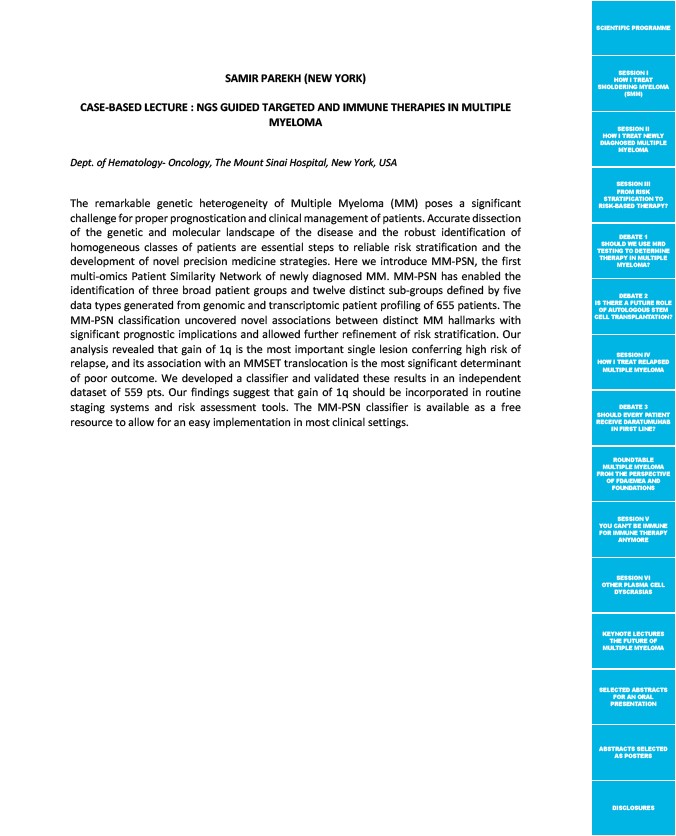
SCIENTIFIC PROGRAMME
SESSION I
HOW I TREAT
SMOLDERING MYELOMA
(SMM)
SESSION II
HOW I TREAT NEWLY
DIAGNOSED MULTIPLE
MYELOMA
SESSION III
FROM RISK
STRATIFICATION TO
RISK-BASED THERAPY?
DEBATE 1
SHOULD WE USE MRD
TESTING TO DETERMINE
THERAPY IN MULTIPLE
MYELOMA?
DEBATE 2
IS THERE A FUTURE ROLE
OF AUTOLOGOUS STEM
CELL TRANSPLANTATION?
SESSION IV
HOW I TREAT RELAPSED
MULTIPLE MYELOMA
DEBATE 3
SHOULD EVERY PATIENT
RECEIVE DARATUMUMAB
IN FIRST LINE?
ROUNDTABLE
MULTIPLE MYELOMA
FROM THE PERSPECTIVE
OF FDA/EMEA AND
FOUNDATIONS
SESSION V
YOU CAN’T BE IMMUNE
FOR IMMUNE THERAPY
ANYMORE
SESSION VI
OTHER PLASMA CELL
DYSCRASIAS
KEYNOTE LECTURES
THE FUTURE OF
MULTIPLE MYELOMA
SELECTED ABSTRACTS
FOR AN ORAL
PRESENTATION
ABSTRACTS SELECTED
AS POSTERS
DISCLOSURES
SAMIR PAREKH (NEW YORK)
CASE-BASED LECTURE : NGS GUIDED TARGETED AND IMMUNE THERAPIES IN MULTIPLE
MYELOMA
Dept. of Hematology- Oncology, The Mount Sinai Hospital, New York, USA
The remarkable genetic heterogeneity of Multiple Myeloma (MM) poses a significant
challenge for proper prognostication and clinical management of patients. Accurate dissection
of the genetic and molecular landscape of the disease and the robust identification of
homogeneous classes of patients are essential steps to reliable risk stratification and the
development of novel precision medicine strategies. Here we introduce MM-PSN, the first
multi-omics Patient Similarity Network of newly diagnosed MM. MM-PSN has enabled the
identification of three broad patient groups and twelve distinct sub-groups defined by five
data types generated from genomic and transcriptomic patient profiling of 655 patients. The
MM-PSN classification uncovered novel associations between distinct MM hallmarks with
significant prognostic implications and allowed further refinement of risk stratification. Our
analysis revealed that gain of 1q is the most important single lesion conferring high risk of
relapse, and its association with an MMSET translocation is the most significant determinant
of poor outcome. We developed a classifier and validated these results in an independent
dataset of 559 pts. Our findings suggest that gain of 1q should be incorporated in routine
staging systems and risk assessment tools. The MM-PSN classifier is available as a free
resource to allow for an easy implementation in most clinical settings.